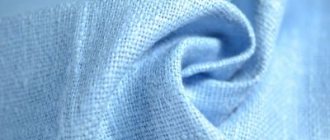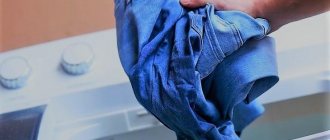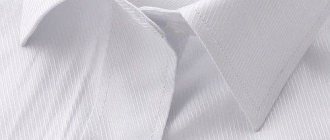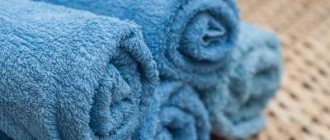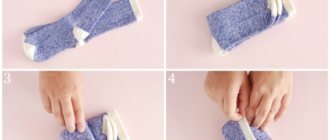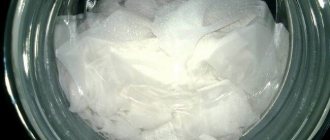Jeans are a universal item that is in every person’s wardrobe, regardless of gender and age. They are worn at any time of the year and for any event.
To ensure that jeans do not lose their attractive appearance for as long as possible, they need to be properly cared for.
There are many washing nuances that every owner of this universal item should know.
How to wash jeans correctly in an automatic washing machine (in what mode, at what temperature) so that they do not lose color, how often, do you need to turn them inside out, do new pants need washing after purchase? You will find answers to these and other questions in the article.
How often should I wash?
Jeans should be washed as they become dirty. In order for them to retain their color saturation longer and not wear out, rare washing is recommended. If minor contamination appears, you can treat a specific area.
The less often the jeans rotate in the drum of the washing machine, the better. However, if a person wears them daily, then they need to be washed once every 7-12 days.
This is done for hygienic purposes. Dirt accumulation in fabric fibers can cause skin irritation.
Telephone: daily
Research has shown that on average we touch a mobile phone 150 times a day, and American scientists found 7,000 different types of bacteria in fifty-one “tests” taken from phones. Some of these bacteria are harmless, but only some are.
“As you use your phone, it heats up, creating the perfect environment for bacteria to grow,” says Laura Bowater, a microbiologist at the University of East Anglia. — Enterococcus (fecal bacteria) and Pseudomonas aeruginosa are serious pathogens, and both have been found on the surface of phones. The worst models are those with a keyboard, due to the thin gaps between the keys. So you need to clean your phone daily using antibacterial wipes.”
How to do it correctly in an automatic washing machine?
The easiest and most affordable way to care for jeans is to wash them in an automatic washing machine. Before you begin the procedure, you need to prepare your pants:
Check the fittings. Zippers, fasteners and buttons must be fastened.- Remove all items from your pockets. To remove dust and other small debris, they should be turned out.
- Check the integrity of the seams. If they have weak fixation, this needs to be corrected.
- If you have a lot of decorations (rhinestones, sequins, stripes, beads, etc.), it is recommended to use a mesh bag for washing things.
After completing the preparatory activities, begin washing. The algorithm of actions should be as follows:
- select the appropriate washing mode;
- place the product in the drum;
- start the wash cycle;
- Remove the jeans and dry them naturally.
If your jeans are seriously soiled, you can soak them using stain remover or bleach (for white fabrics). However, the exposure time in water should be kept to a minimum to avoid fading.
To reduce drying time, you can turn on the spin mode. The optimal speed is 600-800 rpm.
Do I need to turn it inside out?
Jeans must be turned inside out before washing.
There are several reasons for this:
- Color preservation. The less the outer surface of the pants rubs against the drum, the brighter and more saturated the color of the jeans will be.
- Safety of zippers, fasteners and other accessories.
- Preservation of the product's shape. When turned inside out, jeans deform and shrink less.
There is no need to turn the product right side out while drying. This will prevent dust and other contaminants from settling on it.
In what mode (program)?
You can wash your jeans using one of the following modes:
- "Jeans". Most washing machines are equipped with a separate program for washing denim clothes. During their processing, a large amount of foam is released, which reduces the intensity of friction of the product on the drum.
- "Handwash" . This program involves gentle processing of items at minimum speeds.
- “Delicate” or “Gentle”. The settings for these programs vary for different washing machine models. Therefore, before pressing the “start” button, you should make sure that the water temperature and spin speed do not exceed the permissible values.
- Quick wash or Mini 30 cycle . The program involves running a short cycle to give things freshness. Its time can range from 15 minutes to half an hour. This option can be used periodically to wash jeans, since the contact with water is short and the product will not fade much.
You can set the washing parameters yourself, following the manufacturer's recommendations, which are indicated on the product label.
At what temperature?
Denim fabric is made up of cotton fibers. If you expose them to high temperatures, they will shrink. The hotter the water, the greater the degree of shrinkage .
At what degrees should jeans be washed? To avoid becoming the owner of small pants that have shrunk 1-2 sizes, you need to wash them at a temperature of 30-40 degrees. If you make it lower, you will not be able to get rid of stubborn dirt.
Also, you should not allow significant fluctuations in water temperature when soaking . It must remain within the specified range.
This article will tell you whether jeans shrink after washing and how to prevent it. You can find out how to stretch shrunken ones here, how to make stretched ones sit - here.
The best remedy
To wash jeans, you can use regular washing powder labeled “automatic”. However, it is better to give preference to liquid detergent compositions.
There are several reasons for this:
- gels remove stains more effectively;
- they dissolve better in cool water;
- Liquid concentrates are rinsed out faster from thick fabric.
Considering that the duration of the jeans washing cycle is minimal, gel capsules are the best choice. To make the product soft, you can use fabric conditioner.
What can we do together with?
wash jeans with other things if they have a similar color and do not fade . It is important to consider the type of fabric and general recommendations for caring for the products.
Black pants are washed with dark clothes, and light ones with light ones. It is important not only to sort things by color, but also not to overload the drum. It must be taken into account that wet products weigh more.
Read more about what you can wash jeans with and what it is not recommended to do it with, read here.
Typical washing mistakes
Banal laziness or ignorance of the features of jeans leads to minor troubles, and if you are unlucky, then to damage to the pants beyond repair. Don't make these mistakes like other housewives.
Washing with other items
Washing classic blue jeans with white clothes, even at 30 degrees, is a big risk. After such a mistake, housewives take a long time to remove blue stains from T-shirts and shirts.
Wash jeans only with similar fabrics, preferably of similar composition, following the instructions on the labels.
Heat
Washing at 60 degrees or higher often causes jeans to fade, especially if they are black or deep blue.
There is another problem: the fabric shrinks. You risk simply not fitting into your favorite trousers.
Incorrect spin
If you set the washing machine to the most powerful spin, thin jeans may not withstand the load and tear. Reduce speed to avoid excessive wrinkling of the fabric.
Incorrect washing mode
Natural cotton jeans on the “Wool” or “Synthetic” mode may not wash.
Handwash
Hand washing jeans is labor-intensive, but gentle.
Step-by-step algorithm of actions:
Prepare the pants: remove all items and small debris from the pockets, fasten the zippers and buttons, and turn the item inside out.- Fill a bathtub or large basin with warm, but not hot water, and dissolve the detergent in it. You can’t sprinkle it on your pants and then rub it with a brush.
- Immerse the jeans in water without wrinkling or crumpling them.
- If there are complex stains on the pants, they are soaked for 30-40 minutes.
- Stains can be additionally scrubbed with a soft brush. Soap is applied to the stubble, not to the pants.
- After washing, drain the water and rinse the jeans thoroughly.
- When the water has drained, the pants are hung out to dry.
You should not twist your jeans. Excess water can be removed with a terry towel, wrapping the product in it and squeezing it with your hands.
When choosing a washing powder, you need to use one that is intended for manual processing of fabrics. Products labeled “automatic” are not suitable for this purpose.
When washing dark jeans, the water will be intensely colored. This is a normal option and will not affect the final color of the pants. Read about the rules for washing jeans by hand in this article.
Mattress: once every six months
Everything that has been said about pillows also applies to mattresses: dust mites frolic there too, threatening us with an allergic reaction. Moreover, some mattresses can be found to contain Staphylococcus aureus, Campylobacter (which can cause fever, cramps and diarrhea) and norovirus, which remains viable for up to six weeks in favorable mattress conditions.
“It’s important to vacuum or steam and then air out your mattress at least every six months,” says Laura.
Stains can be removed with a cloth soaked in cold water and upholstery shampoo. After cleaning, it would be a good idea to turn the mattress over. As for a machine washable mattress cover, it is a great investment in your own health.
Rules for light and dark products
Features of washing white items:
You can use products containing a bleaching component.- You can wash your pants at temperatures up to 60 degrees, if there is an urgent need for it.
- When hand washing, careful consideration and rinsing of the seams is necessary. If this is not done, gray or yellow streaks will remain on your pants.
Features of washing dark:
- do not use formulations containing bleaching granules for washing;
- to preserve color, you can use washing powder for black fabrics;
- The maximum washing temperature is 30 degrees.
You need to wash white and dark jeans separately - this is the most important rule that cannot be broken. You can learn about the rules for washing black jeans from this article.
Useful tips
Little tricks will help enhance the effectiveness of the cleansing procedure:
- If there is no washing powder or gel in the house, you should not postpone the procedure. Grated laundry soap is great for removing various types of dirt, both manually and by machine.
- It is not advisable to twist and wring out the product; it is better to let the water drain on its own.
- It is necessary to dry away from heating devices in the fresh air.
- It must be hung from the belt.
- It is preferable to wash jeans by hand; machine cleaning can cause damage to the product.
How often to wash jeans is up to everyone to decide for themselves, but you should understand that too frequent use of synthetic products and water can wash out even the most durable colors.
It’s clear how to wash jeans without ruining them. Put into practice the tips and recommendations, then your clothes will be in perfect order for a long time.
Many housewives are annoyed after washing when they see that their colored linen has faded. How to wash correctly, Items made of viscose look very beautiful and bright, but due to improper care they become very fast, Natural fabrics are expensive, but cause certain difficulties when washing. To remove contaminants you will need, Properly washing and drying a down jacket is a whole science, because due to poorly selected
How to make sure they don't lose color?
To avoid color loss, you must adhere to the following recommendations:
- wash the product as rarely as possible;
- minimize contact with water;
- after the first wash, rinse the jeans in vinegar water (3 tablespoons per 10 liters);
- use liquid detergent;
- Do not use aggressive compounds containing chlorine or acids.
Local stains are removed immediately. This will make it easier to get rid of dirt and not have to resort to soaking.
How to freeze jeans to make them last longer
One way to extend the life between washes is to freeze them. One of the reasons why denim starts to get dirty is because bacteria is transferred from our body to the material during wear, which can cause an unpleasant odor. Freezing jeans can kill 100% of bacteria, helping to clean the fabric and providing a laundering alternative. After all, they are well preserved, which extends their service life significantly.
- Fold several times, or twist.
- Place the jeans in a fabric bag or any other breathable bag. The main thing is not to use plastic ones.
- Open the freezer and leave for at least a day.
Wearing your jeans once or twice doesn't mean it's time to throw them in the wash with the rest of your clothes. They have a completely different life expectancy. Wait until the denim begins to stretch at the knees and the waist is extremely loose.
Do I need to wash new ones immediately after purchase?
There are several arguments for and against washing jeans after purchase.
The main argument in favor is that new pants are always painted and sometimes quite heavily . This applies not only to cheap, but also to expensive branded items.
A light wash without using detergents will remove excess pigment and prevent it from transferring to the skin of your feet or other things.
Also, with the help of the first wash, you will be able to get rid of the unpleasant odor that may be present on the new product. Wash jeans after purchase for hygienic purposes. It is possible that other people tried them on before purchasing the pants.
The main argument against washing is the fact that the color of the product may become less saturated . To avoid this problem and fix the dye, it is recommended to add 9% vinegar to the water (3 tablespoons per 10 liters of water).
Sometimes they refuse to do laundry because they want to put on a new item as quickly as possible. However, hygiene rules should not be neglected. Moreover, the washing and drying process will take no more than 10-12 hours.
How to Get White Stripes on Your Jeans
One of the sharpest arrows in any denim lover's heart is pulling your dear beau out of the washing machine and finding the dreaded white streaks materializing on them.
“White streaks are caused by harsh chemicals used in the washing process, undissolved detergent, mineral deposits in hard water, or friction on the fabric, which can cause color loss,” Fr.
How to soften fabric if it has become stiff?
If your jeans become stiff after washing, you can fix this by using the following tips:
- Twist your pants and hit them on the corner of the table.
- Wrap the jeans in a bag and roll them with a rolling pin.
- Put your pants on, wet them with a spray bottle and go about your business. The wet fabric will become softer as you wear it.
- Wash the item again using fabric softener. If you don't have it, you can use hair rinse.
- Steam jeans using a steam generator.
Some users recommend washing jeans in a washing machine along with tennis balls. This method must be used with caution.
Balls cause additional friction to the fabric, which can lead to rapid wear. Although jeans do become softer after washing this way.
Is it possible to wash jeans every day?
Pants made of thick cotton are not clothes that need regular washing. Moreover, frequent exposure to detergent water can cause damage to clothes and cause color loss. According to statistics, half of people wash a pair of trousers after only 5 wears, and another third wear cotton trousers up to 9 times before washing them. How to extend the wear life of jeans from one wash to another:
- It is advisable to maintain a weekly interval between washes. After each wear, thick cotton trousers can be hung out in the fresh air for a short time. This will allow the fabric to dry and remove any accumulated odors.
- Remove stains with a sponge. If a stain appears on freshly washed jeans, it is better to remove it with a sponge soaked in soapy water or dishwashing detergent. Complex stains are treated with ammonia or vodka.
- Use a steamer. A steamer allows you to restore the brightness of color and freshness of fabric. If there is no special device, then you can lightly moisten the cotton trousers from a spray bottle with water and some conditioner added. Afterwards, the product should be ironed through gauze or thin material.
It should be remembered that in some cases you can replace the usual washing with freezing. Denim trousers are wrapped in plastic wrap or placed in a ziplock bag. The product is then left in the freezer overnight. When exposed to cold, trousers acquire amazing freshness without jeopardizing their own fibers.
Drying Features
There are several nuances that you need to pay attention to when drying jeans:
They are hung upside down.- The product should be secured to the belt. This position will avoid deformation of the fabric and allow the pockets to dry faster.
- Do not dry jeans near heat sources, such as a radiator.
This will cause them to shrink. For the same reason, jeans are not dried with a hot stream of air. - Pants should not be hung in direct sunlight. Ultraviolet light promotes their fading. White fabric may turn yellow.
How long does it usually take for jeans to dry? If they were washed in a washing machine with a spin cycle, the water will completely evaporate in 3-4 hours. After hand washing, this process may take 1-2 days.
It is best to dry your pants naturally , in a room with low humidity. You can learn about ways to dry jeans after washing here.
Why jeans fade and how to deal with it
Have you ever been caught in a warm summer rain wearing new jeans, and then looked in bewilderment at your legs, painted a “pleasant” blue?
This is quite normal! Excess dye may wash out of the fabric of jeans you just bought.
It is worth mentioning one more fact - indigo itself is an unstable dye (except for special permanent dyes for “fadeless” jeans) and does not dissolve in water. Thanks to this fact, beautiful abrasions are formed - fading.
How to wash jeans correctly so they don’t lose their color?
It’s not difficult to get rid of such a scourge, the main thing is to act wisely. So, what can you do to prevent your pants from fading?
- No matter how dirty the product is, do not wash it in hot water! The higher the water temperature, the more denim fades!
- By washing your jeans without turning them inside out and spinning them, during the first wash you can “catch” some pretty unsightly creases in the wrong place and it will be impossible to get rid of them, and also lose a large amount of dye.
- Use washing powders for denim, color stabilizer.
- When soaking or washing, add a little table vinegar to the water (it is enough to add 4 tablespoons of vinegar to a bowl of water), which will fix the paint on the fabric.
- Vinegar can be replaced with salt.
- Don't dry your jeans in the open sun if you don't want it to “eat away” the color. In the old days, cotton fabric was bleached by spreading it out in the bright sun.
Do I need to iron it?
If you hang wet jeans from your waistband, they will straighten out on their own under their own weight. This eliminates the need for ironing.
When it is still necessary, for example, in order to soften a thing, adhere to the following recommendations:
- Do not iron dry fabric. The pants should remain slightly damp. If time is lost, they can be moistened using a spray bottle.
- The product can only be ironed from the reverse side.
- It is recommended to set the iron temperature to 150 degrees. The thinner the fabric, the lower it should be.
- To prevent pocket marks from remaining on the trouser leg, you need to put a handkerchief in it. First, iron the seams and the back side, then the pockets and the front surface of the product.
After ironing is completed, the jeans should be allowed to cool so that they are fixed in the desired position.
Read about how to iron jeans here.
Bed linen: once a week
We shed millions of skin cells every day, and a fair portion of them stay in bed. In addition, on average a person produces about a liter of sweat per night. Both attract dust mites.
These mites themselves are harmless, but their waste products are powerful allergens that can cause itchy eyes, rhinitis (in other words, a runny nose) and even asthma. So here's a worrying fact: one in ten people only change their bed linen every four weeks, and a third of housewives wait two weeks before changing their sheets and pillowcases.
So microbiologists insist on washing bed linen weekly at a temperature of at least 60 degrees: this way, most bacteria can be destroyed. Ideally, bedding should be dried in the sun: ultraviolet radiation is destructive to many microorganisms. And to effectively complete the “bacterial genocide,” iron your laundry on the “cotton” setting—a temperature of 200 degrees will kill off any remaining germs.
How to remove difficult stains?
If your jeans get paint or other stains that cannot be removed in the usual way, you need to resort to special means. The method of their use is indicated in the table:
| Stain type | An effective remedy | Mode of application |
| Wine | Hydrogen peroxide | Prepare a solution: 2 tablespoons of peroxide per 200 ml of water. Soak a cotton pad in it and gently work the fabric until the stain disappears completely. |
| Dye | Turpentine | The product is applied to a cotton swab in its pure form. Apply cotton wool to the contaminated area and leave for 15 minutes. Wipe the fabric with a clean swab. |
| Zelenka | Ammonia | Alcohol is applied to jeans in its pure form. Leave the composition for 15 minutes. Wipe the stain with a cotton swab until it disappears completely. Additionally, you should wash the contaminated area with laundry soap. |
| Blood | A solution of salt, soda and vinegar | Mix salt with soda and cover the stain with this powder. After five minutes, vinegar with a concentration of 9% is applied to it. The mixture is left until the reaction is complete. Wash jeans in cool water. Do not soak blood stains in hot water, as this will cause the protein to coagulate. It will be difficult to get rid of such pollution. |
| Iodine | Milk | Milk is applied to the stain. Leave for 15 minutes. Remove the stain using laundry soap and a soft brush. |
You can learn how to remove grass stains from jeans here. Read about removing grease stains from denim here.
Dog: once every two months
A dog's immune system can cope with many bacteria, so we wash our pets mainly for our own benefit. However, they can pick up skin parasites, causative agents of skin diseases, such as cheyletiosis, which is also dangerous for humans. So veterinarian Rosie Barclay recommends washing your dog once every two months.
“By washing your dog more often, we destroy the protective fatty layer of his skin and the natural “water-repellent impregnation” of the coat, which the animal simply needs, especially in winter,” says Rosie. “If the coat seems too oily or there is an unpleasant odor, then it’s time for a bath . If the dog gets dirty during a walk, then it is better to rinse it in the shower without using shampoos or other detergents.”
Important Tips
To make washing your jeans as effective as possible, you must use the following recommendations:
Do not ignore the manufacturer's advice. They are indicated on the product label. It is always on the wrong side of the jeans.- Do not actively rub dirt on your jeans with a brush.
This will cause stains. The fibers of the fabric will become fuzzy, which will affect the appearance of the product. - The powder must be dosed strictly. Its excess will remain in the fibers of the fabric, which will require additional rinsing of the item.
If creases in the form of white stripes appear on your pants during drying, you need to moisten them with water and wait until they dry again.
You will find maximum useful information about washing clothes and various fabric products here.
Bra: after every second wear
Kelly Dunmore, lingerie expert at Rigby & Peller, insists that you should wash your bra after you've worn it twice, or three at most. “The bust area and especially the armpits are an inexhaustible source of sebum and sweat.”
Difficulties await us here: it is not recommended to wash bras in a machine, since this destroys the elasticity of the fabric fibers and reduces the life expectancy of expensive underwear: with proper care, the bra should last at least a year.
So the underwire miracle needs to be washed by hand and then dried at room temperature, spread on a towel: the heat of a radiator or dryer destroys the lycra.
Bag: once a week
Just look at the bottom and handles of your bag and you'll never throw it on the bed or put it on the kitchen counter again. The bag goes with us everywhere: in markets, in transport, in public toilets. We hold the subway counters with our hands and then grab the handles of our bags.
“It’s best to wipe down your bag with antibacterial wipes once a week,” says the microbiologist. “This way you can get rid of staphylococcus, viruses and other disease carriers.”
Of course, before cleaning the entire bag, test the product on a small area in an inconspicuous place: it would be a shame to destroy good leather because of your fear of crumbling, but numerous and dangerous creatures.
Wallet: once a week
“Fecal bacteria, E. coli or Staphylococcus aureus can be found in almost any public place,” explains Laura. “Even if you wash your hands regularly, germs can end up on your wallet if it’s placed on a table or an insufficiently wiped down café counter.”
Specialists from St. Petersburg (Florida) conducted a large-scale study: they looked for bacteria on money. It turned out that staphylococcus lives on 80% of banknotes, as well as on half of the credit cards studied. The differences are clear: paper has more pores than plastic. So your wallet needs to be disinfected once a week - for your own safety.
Exception to the rule
Experts say that in the only case that washing can be beneficial for denim, it is when the material contains some elastane. As a rule, such things tend to stretch quite quickly, but interaction with water allows them to take their previous shape and a more beautiful appearance.
By the way, if you need to narrow your jeans, you need to put them on yourself and then lie down in a bath with hot water. Now you should wait until the temperature of the contents drops, and, after removing your clothes, dry them naturally.


